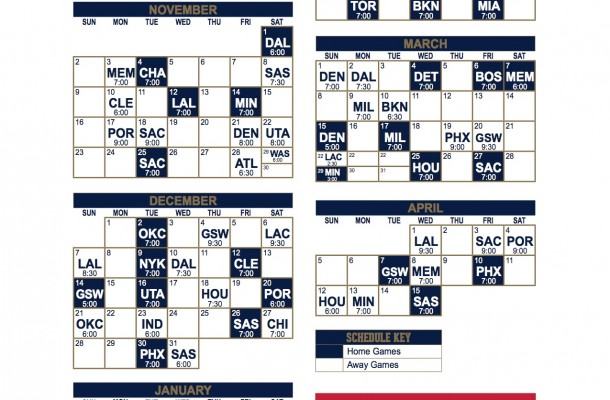This past season, a lot of debate emerged in the NBA about the seeding system in the playoffs, which protected division winners and was not arranged in a conference-blind 1-through-16 format. These debates were important, and public discussion did create enough pressure to make the NBA reconsider the structure of its playoff seeding system. The league and commissioner Adam Silver are strongly weighing the idea of revoking the protections given to division winners. That’s a forward step, and one hopes the NBA will follow through.
However, that’s far from the only way the NBA needs to revise the layout of its season. The playoffs, on the back end, are very important, but the regular season — the front end — also matters.
One aspect of the way the NBA structures its season — which affects the playoffs, but not as directly as seeding — has generally escaped further discussion, very much including the past 12 months. It bears mentioning now, so that perhaps in a year’s time, public pressure can generate reform in this area as well: regular-season scheduling, particularly in connection to the number of games allotted to both conferences and divisions.
In baseball, teams play over 70 of 162 regular-season games in their own divisions, a substantial and properly proportionate chunk. If you want to win your division, chances are you’ll need to play reasonably well in your division. It’s only right that it should be that way. The same goes for the NFL, in which teams play six of 16 games in their own divisions. NFL teams also play 12 of 16 games in their own conference, so when playoff seeds for the two conferences emerge, one can accurately say that those seeds primarily reflect a team’s level of quality in its own conference. Sure, a 4-0 or 0-4 record in non-conference games can skew one’s track record within a native conference, but for the most part, NFL playoff seeds do at least acknowledge how a team performs in its own conference.
In the NBA, then, it just doeesn’t seem that the casual sports fan realizes how little a team plays in its own division and conference during the 82-game regular season.
The conference angle is the less alarming issue on the table, since NBA teams do play 50 of 82 games within their own conference. That’s tolerable — just over 60 percent of games in a long season are played in one’s own conference. However, it should give NBA leaders pause that only 16 of 82 games are played within one’s own division, with four games occurring against four divisional opponents.
Let that last point sink in: 16 of 82 represents a figure below 20 percent. NBA teams don’t even play one out of every five games within their own division. This is precisely why division championships mean nothing in the NBA, and should accordingly not be protected in the playoff seeding structure. However, this should lead Adam Silver to consider the notion of why divisions exist in the first place.
It would seem to be the case that the NBA should want its players fresher in general, and especially for the playoffs. Installing a longer All-Star break and cutting down on back-to-back sets plus those dreaded “four games in five nights” stretches represent important forward movements by the league. Therefore, it’s important to stress that Silver has already done a lot of great things to improve the league and help players cope with what is still a hugely demanding regular season.
The next step, a year from now, is to arrive at one of two fundamental reforms of the regular-season schedule. Either the league should do away with divisions — in which a decision to keep the current distributions of games makes sense, since said distribution is based more on conference balance than divisional balance — or it should pursue a path which makes divisions relevant.
The way one makes divisions relevant is simply to put more in-division games on the schedule.
*
Let’s put it very simply: If divisions matter, and moreover, if the NBA values lowering the carbon footprint of air travel over the course of the season (in much the same way that the league went to the 2-3-2 format in the 1985 NBA Finals, to cut down on long Boston-to-Los Angeles plane flights), it will implement a basic change to the regular season slate.
The NBA, if it values divisional competition and environmental outreach (which are perfectly reasonable goals), will have teams play in one of three basic schedule layouts:
A) 24 games in the division, 52 games in conference, 30 out of conference;
B) 28 games in the division, 67 games in conference, 15 out of conference;
C) 32 games in the division, 52 games in conference, 30 out of conference.
Option C is the cleanest one: 8 games per divisional opponent, 2 games per non-division conference opponent, and 2 games per non-conference opponent. However, option B would really cut down on travel, making it more attractive. Option A would still provide balance between divisional and conference play, but even the modest addition of eight more divisional games would represent a substantial improvement upon what we have now.
Just 16 divisional games per season? Not even one out of every five games in one’s own division? Surely, the NBA needs to revisit its regular-season layout in the coming year.
